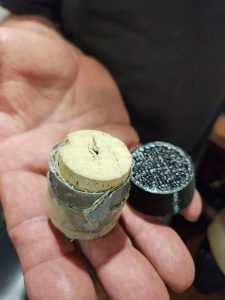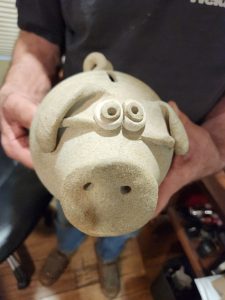The more I use 3D printing, the more I use it for.
Not everything is art. I’ve written before here about some of the crazy things I’ve made, like container tops, game boards, brass dice, candleholder trays, kitchen container tops, a new fan part for my 8-foot-tall Cerebus 3D Gigante 3D printer, knobs for my metal slip roll, rollers for our office window, a replacement part for folding table, a catbox litter scoop, an RC excavator bucket, a door stop, a doorstop and, recently, a piggy bank plug. Some have been more successful than others. (That kitty poop scoop was fun.)
One of the keys to being able to make, say, a replacement part – which also serves me when making sculptures – is mastery of CAD (Computer Aided Design) software. I won’t claim that I have mastered Alibre Design and Rhino, but I’ve definitely gotten better at getting my tolerances right.
That really came in handy recently when I decided to replace the plug on my much-beloved piggy bank, which yes, looks like a pig.
 I’ve hauled this thing around with me since before I was in the Navy, so probably 50 years (yikes!), filling it with coins many times. Over the years, though, the cork plug that keeps those “millions” inside Piggy got looser and looser.
I’ve hauled this thing around with me since before I was in the Navy, so probably 50 years (yikes!), filling it with coins many times. Over the years, though, the cork plug that keeps those “millions” inside Piggy got looser and looser.
Years ago I wrapped some duct tape around the cork, which worked as a stopgap, but hey! now I have a 3D printer.
It took me a few tries to get the angle just right, but now I have a cool black plug that is tapered just right to stopper Piggy. And if this one needs adjustment, I have the file ready to tweak.
Projects like this that require exact tolerances used to make me crazy because, as a self-taught CAD user, I was learning everything on the fly. I guess practice has made more perfect, as it so often does.
